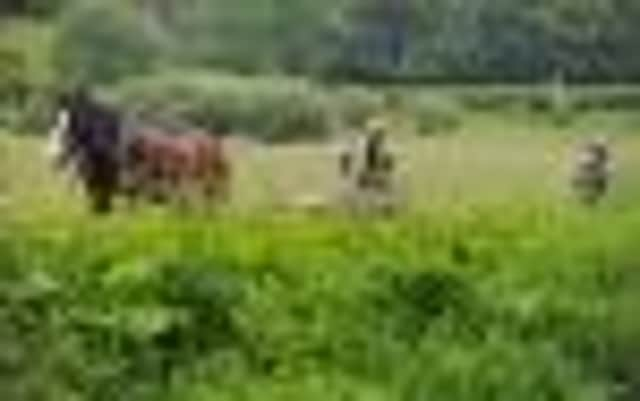75 years on, horses return to haul wagons at a Malton mill


In 1755, the first wooden carts started being hauled across the small tree-covered island in the river Derwent, to Howsham Mill, near Malton.
Designed by architect John Carr, better known for Fairfax House in York and the extension to the stables at Castle Howard, it operated as a functioning corn mill for nearly 200 years.
Advertisement
Hide AdAdvertisement
Hide AdBut in 1947, with the estate of nearby Howsham Hall split up to pay off death duties, the island was sold off and the mill where it was situated fell silent.
Now 75 years after they were last used, horses have again been hauling wagons across the island meadows towards the Grade II-listed building, as the final stage of a long-running £1.1 million restoration project gathers pace.
The derelict mill was bought by Mo MacLeod and husband Dave Mann in 2004, who formed the Renewable Heritage Trust (RHT) to bring it back to life.
In 2007, they installed a modern waterwheel and a hydropower system based on the Archimedean screw principle, to generate electricity and help fund the project in the long term.
Advertisement
Hide AdAdvertisement
Hide AdAnd following a recent £640,000 grant from the Heritage Lottery Fund, the final rebuilding work is taking place.
With modern day trucks unable to transport materials to the mill without churning up the island where there is a colony of breeding otters and 86 varieties of wildflower, local building contractor Stephen Pickering is transporting the scaffolding and huge timbers required using a horse and cart.
Mrs MacLeod, a 44-year-old mother-of-two and chair of the restoration trust, said: “From the outset this has never been a straightforward project.
“The mill is a Grade II-listed building situated in a site of special scientific interest, a European special area of conservation, an area of outstanding natural beauty, a local conservation area and an historic parkland with no vehicular access.
Advertisement
Hide AdAdvertisement
Hide Ad“The main focus for the RHT has always been on finding imaginative ways to undertake the rebuild without damaging either the natural or historic environment.
“Stephen has loads of experience of working on historic buildings for local estates including Castle Howard, so we knew he’d be perfect for the job.
“For this final stage we are completely rebuilding the main bit of the building out of the original stonework which makes it so unique.
“It is lovely to see the horses coming across.
“They have been doing that for hundreds of years.”
The restoration project marks a dramatic change in the fortunes of the building which its former owners attempted to pull down in 1965, before it was listed by the HBMC (Historic Buildings and Monuments Commission, which became English Heritage) as it was “a rare example of Gothic Revival style as applied to a functional building”.
Advertisement
Hide AdAdvertisement
Hide AdIts dual purpose as a working mill and grand garden folly for Howsham Hall makes it one of only two such buildings in the UK – the other is on the Chatsworth estate in Derbyshire.
In 2006 the mill was one of the participants in the BBC’s Restoration Village series, hosted by Griff Rhys Jones.
The project made it to the finals and was the regional winner for the North of England for which they were awarded £50,000.
When the mill restoration is complete, it is to be opened as an educational facility and a community centre.
Advertisement
Hide AdAdvertisement
Hide AdThe finished building will house a permanent exhibition on the history of the mill, and an extensive library on climate change and renewable energy.
The Archimedean Screw is now generating enough electricity to power the whole of the nearby village of Howsham, and around £30,000 a year for the trust.
Last year it hosted the first ever hydropowered outdoor film screening in association with Screenwaves, a pilot scheme bringing cinema to rural areas
The aim is to make the building totally self-sustaining, with all the money earned from the hydropower sales being used to fund the restoration.
Advertisement
Hide AdAdvertisement
Hide Ad“We are hoping to have school trips to come and learn about the heritage of the area,” Mrs MacLeod said.
“And we are open to all suggestions.
“Absolutely what has happened here I am hoping can be replicated at many other historic buildings across Yorkshire.”